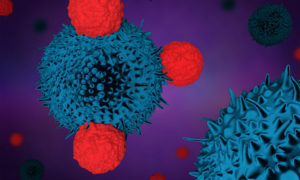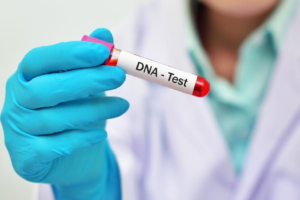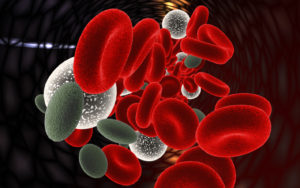Bay Biosciences provides fresh frozen (-80°) high quality tumor tissue samples, clinical grade sera (serum), plasma and peripheral blood mononuclear cells (PBMC) biofluid samples biofluid samples processed from Non-Hodgkin’s Lymphoma (NHL), Diffuse Large B Cell Lymphoma (DLBCL) type.
Sera (serum), plasma and PBMC biofluid samples are processed under customized processing protocols using patients whole blood. Bay Biosciences also provides matching formalin fixed paraffin embedded (FFPE) tumor tissue samples from unique advance stage untreated, Non-Hodgkins Lymphoma (NHL), Diffuse Large B Cell Lymphoma (DLBCL) patients.

Non-Hodgkin’s Lymphoma Overview
Non-Hodgkin lymphoma (NHL) is a term that refers to a group of several, very different types of lymphomas. Lymphoma is a cancer of the lymphatic system (solid tumors of lymphoid tissues). Lymphoma usually begins when healthy cells in the lymphatic system change and grow out of control, which may form a tumor. Lymphoma begins when healthy B cells, T cells, or NK cells in the lymphatic system change and grow out of control, which may form a tumor. B-NHLs account for up to 90% of all NHL cases. Occasionally, lymphoma can also begin outside the lymph node system known as extranodal, this mostly develops in children.
Because lymph tissue is found in so many parts of the body, NHL can start almost anywhere and can spread to almost any organ in the body. It most often begins in the lymph nodes, liver, or spleen but can also involve the stomach, intestines, skin, thyroid gland, or any other part of the body.
Non-Hodgkin’s Lymphoma (NHL), is a cancer that starts in white blood cells called lymphocytes, which are part of the body’s immune system. Non-Hodgkin’s lymphoma originates in the lymphatic system, the disease-fighting network spread throughout the human body. In non-Hodgkin’s lymphoma, tumors develop from lymphocytes, which are a type of white blood cells.
Non-Hodgkin’s Lymphoma starts when the body produces too many abnormal lymphocytes or white blood cells. Usually lymphocytes go through a predictable life cycle, Old lymphocytes die and the body creates new ones to replace them. In non-Hodgkin’s lymphoma, the lymphocytes don’t die, but continue to grow and divide. This oversupply of lymphocytes crowds into your lymph nodes, causing them to swell.
Non-Hodgkin’s lymphoma is more common than the other general type of lymphoma’s like Hodgkin’s lymphoma. There are many different subtypes of non-Hodgkin’s lymphoma like Diffuse large B-cell Lymphoma (DLBCL) and Follicular Lymphoma are among the most common subtypes.
Non-Hodgkin’s lymphoma generally involves the presence of cancerous lymphocytes in the lymph nodes. But the disease can also spread to other parts of the lymphatic system. These include the lymphatic vessels, tonsils, adenoids, spleen, thymus and bone marrow.
Types of Non-Hodgkin’s Lymphoma
Following are the most common types and subtypes of Non-Hodgkin’s Lymphoma (NHL):
- B-cell lymphoma. About 90% of patients in with lymphoma suffer from B-cell lymphoma.
- T-cell lymphoma. About 10% of patients with lymphoma have T-cell lymphoma. These lymphomas are more prevalent in Asian countries.
- NK-cell lymphoma. Less than 1% of people with lymphoma have NK-cell lymphoma.
Non Hodgkin’s Lymphoma is also described by how quickly the cancer is growing, either indolent (these types of lymphoma grow slowly) or aggressive, these types of lymphoma may develop rapidly.
Sub Types of Non-Hodgkin’s Lymphoma
Following are the most common subtypes of Non-Hodgkin’s Lymphoma as described below:
Common subtypes of B-cell lymphoma are:
- Diffuse large B-cell lymphoma (DLBCL)
- Follicular lymphoma
- Mantle cell lymphoma
- Small lymphocytic lymphoma (also known as B-cell chronic lymphocytic leukemia -CLL)
- Double hit/triple hit lymphoma
- Primary mediastinal large B-cell lymphoma
- Splenic marginal zone B-cell lymphoma
- Extranodal marginal zone B-cell lymphoma of MALT
- Nodal marginal zone B-cell lymphoma
- Lymphoplasmacytic lymphoma
- Primary effusion lymphoma
- Burkitt lymphoma/Burkitt cell leukemia
According to the American Cancer Society (ACS) it is estimated that 85 percent of NHL cases are B-cell lymphomas. The most common types of B-cell lymphomas are diffuse, large B-cell lymphoma, which accounts for 1 out of every 3 cases in the United States and follicular lymphoma, which accounts for 1 out of every 5 cases in the United States.
Common subtypes of T-cell and NK-cell lymphoma are:
- Anaplastic large cell lymphoma, primary cutaneous type
- Anaplastic large cell lymphoma, systemic type
- Breast implant-associated anaplastic large cell lymphoma
- Peripheral T-cell lymphoma, not otherwise specified (NOS)
- Angioimmunoblastic T-cell lymphoma
- Adult T-cell lymphoma/leukemia (human T-cell lymphotropic virus type I positive)
- Extranodal NK/T-cell lymphoma, nasal type
- Enteropathy-associated T-cell lymphoma
- Hepatosplenic T-cell lymphoma
- Subcutaneous panniculitis-like T-cell lymphoma
- Mycosis fungoides (rare type of T-cell lymphoma)
Non-Hodgkin’s Lymphoma Signs and Symptoms
Patients with Non-Hodgkin’s Lymphoma (NHL) may experience a variety of symptoms. However, many people, especially those with follicular lymphoma, small lymphocytic lymphoma, marginal zone lymphoma, and indolent subtypes, will have no symptoms. Conditions that are not lymphoma can also cause many of these symptoms. Generally symptoms of NHL depend on where the cancer started and the organ that is involve
Following are the general signs and symptoms of Non-Hodgkin’s Lymphoma (NHL):
- Abdominal Pain and swelling
- Enlarged lymph nodes in the abdomen, groin, neck, or underarms
- Chest Pain
- Enlarged spleen or liver
- Coughing
- Fever that cannot be explained by an infection or other illness
- Weight loss with no known cause
- Excessive sweating and chills
- Fatigue
Following are the examples of signs and symptoms of NHL related to a specific tumor location:
- A tumor in the abdomen can cause a stretched belly or pain in the back or pain in the abdomen.
- An enlarged spleen may cause back pain and a feeling that the stomach is full.
- A tumor in the groin may cause swelling in the legs.
- A tumor in the underarms may cause swelling in the arms.
- If the lymphoma spreads to the brain, there may be symptoms similar to those of a stroke.
- A tumor in the center of the chest may press on the trachea and cause coughing, chest pain, difficulty breathing, or other respiratory problems.
Non-Hodgkin’s Lymphoma Causes
Causes of Non-Hodgkin’s Lymphoma are unknown. Researchers believe NHL develops when the body makes too many abnormal lymphocytes. These abnormal cells don’t die and continue to grow and divide. This process enlarges the lymph nodes.
Non-Hodgkin’s Lymphoma Risk Factors
Many patients with Non-Hodgkin’s Lymphoma have no obvious risk factors. It’s also possible to have multiple risk factors and never develop NHL. The exact cause of NHL is not known, and most patients diagnosed with NHL will not know what caused the disease. However, the following factors may raise a person’s risk of developing NHL:
- Age: The risk of NHL increases with age, it occurs most often in people in their 60s and 70s.
- Gender: Men are very slightly more likely to develop NHL than women
- Immunosuppressant Medicines: the use of immunosuppressant drugs may increase the risk of developing NHL.
- Bacterial Infections: Some types of NHL are associated with specific infections. For example, mucosa-associated lymphoid tissue (MALT) lymphoma of the stomach is caused by an infection caused by bacteria called Helicobacter pylori.
- Viruses: Particularly Epstein-Barr virus can cause NHL.
- Immune deficiency disorders: Such as HIV/AIDS
- Genetic factors: Certain genetic factors may be there for inherited risk factors for NHL.
- Obesity: Being overweight or having a diet filled with fatty foods or red meat may increase the risk of lymphoma.
- Chemical exposure: Exposure to certain chemicals may increase the risk of NHL. This may include pesticides, herbicides (like Agent Orange), and petrochemicals, exposure to chemicals, such as weed and insect killers.
- Exposure to ionizing radiation: This can include exposure to radiation from atomic bombs, nuclear reactor accidents, and medical radiation therapy.
- Autoimmune disorders: Patients with autoimmune disorders, such as rheumatoid arthritis
and Sjögren syndrome, increases the risk of developing certain types of NHL. - Organ transplantation: Organ transplant recipients have a higher risk of NHL
- Previous cancer treatment: Previous treatment with certain drugs for other types of cancer
may increase the risk of NHL. - Vaccines: Certain vaccinations such as Bacillus Calmette–Guerin (BCG) may increase the risk of developing NHL.
- Breast implants: Having breast implants can increase the risk of breast lymphomas.

Detailed clinical data and pathology annotations including Non-Hodgkin’s Lymphoma patient’s corresponding diagnostic test values are provided to a valued pharmaceutical customer for research, development and discovery.
Bay Biosciences is a global leader in providing researchers with high quality, clinical grade, fully characterized human tissue samples, bio-specimens and human bio-fluid collections from cancer (tumor) tissue, cancer sera (serum), cancer plasma, cancer PBMC and human tissue samples from most other therapeutic areas and diseases.
Bay Biosciences maintains and manages it’s own bio-repository, human tissue bank (biobank) consisting of thousands of diseased samples (specimens) and from normal healthy donors available in all formats and types. Our biobank procures and stores fully consented, deidentified and institutional review boards (IRB) approved human tissue samples and matched controls.
All our human human tissue collections, human specimens and human bio-fluids are provided with detailed samples associated patient’s clinical data. This critical patient’s clinical data includes information relating to their past and current disease, treatment history, lifestyle choices, biomarkers and genetic information. Patient’s data is extremely valuable for researchers and is used to help identify new effective treatments (drug discovery & development) in oncology, other therapeutic areas and diseases. This clinical information is critical to demonstrate their impact, monitor the safety of medicines, testing & diagnostics, and generate new knowledge about the causes of disease and illness.
Bay Biosciences banks wide variety of human tissue samples and biological samples including cryogenically preserved -80°C, fresh, fresh frozen tissue samples, tumor tissue samples, FFPE’s, tissue slides, with matching human bio-fluids, whole blood and blood derived products such as serum, plasma and PBMC’s.
Bay Biosciences is a global leader in collecting and providing human tissue samples according to the researchers specified requirements and customized, tailor made collection protocols. Please contact us anytime to discuss your special research projects and customized human tissue sample requirements.
Bay Biosciences provides human tissue samples (human specimens) from diseased and normal healthy donors; including peripheral whole-blood, amniotic fluid, bronchoalveolar lavage fluid (BAL), sputum, pleural effusion, cerebrospinal fluid (CSF), serum (sera), plasma, peripheral blood mononuclear cells (PBMC’s), saliva, Buffy coat, urine, stool samples, aqueous humor, vitreous humor, kidney stones, renal calculi, nephrolithiasis, urolithiasis and other bodily fluids from most diseases including cancer. We can also procure most human bio-specimens and can do special collections and requests of human samples that are difficult to find. All our human tissue samples are procured through IRB approved clinical protocols and procedures.
In addition to the standard processing protocols Bay Biosciences can also provide human plasma, serum, PBMC bio-fluid samples using custom processing protocols, you can buy donor specific sample collections in higher volumes and specified sample aliquoting from us. Bay Biosciences also provides human samples from normal healthy donors, volunteers, for controls and clinical research, contact us Now.
日本のお客様は、ベイバイオサイエンスジャパンBay Biosciences Japanまたはhttp://baybiosciences-jp.com/contact/までご連絡ください。

